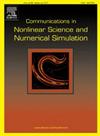Implicit unified gas-kinetic scheme for steady state solution of hypersonic thermodynamic non-equilibrium flows
IF 3.4
2区 数学
Q1 MATHEMATICS, APPLIED
Communications in Nonlinear Science and Numerical Simulation
Pub Date : 2024-09-25
DOI:10.1016/j.cnsns.2024.108367
引用次数: 0
Abstract
The unified gas-kinetic scheme (UGKS), designed to solve Boltzmann equation and its model equations, aims to accurately resolve multi-scale flow problems within a single computation framework. In this study, an implicit UGKS is proposed for the steady state solution of diatomic gas flows based on a multiple-temperature Boltzmann model equation with non-equilibrium among translational, rotational and vibrational modes (Zhang et al., 2023), utilizing a novel hybrid Cartesian-unstructured discrete velocity space (DVS) mesh approach. The multiple-temperature macroscopic equations corresponding to the Boltzmann model equation are simultaneously solved implicitly to address the stiffness and nonlinearity of the collision operator encountered when solving the Boltzmann model equation in isolation. Both macroscopic equations and Boltzmann model equation are solved by using the point relaxation symmetric Gauss–Seidel method to achieve a fast convergence rate. The efficiency of the implicit UGKS can be improved by about two orders of magnitude compared to the explicit one. Moreover, the hybrid Cartesian-unstructured DVS achieves a noteworthy reduction in both CPU-hours and memory consumption, requiring only 15%23% of the advanced unstructured DVS. It effectively alleviates the dimensional crisis of UGKS in solving three-dimensional hypersonic flows, and can be extended to other DVS-based methods. As a result, UGKS extends its applicable regime to simulations of hypersonic thermodynamic non-equilibrium flows with Mach numbers up to 30, achieving three-dimensional flow simulations of complex geometrical configurations with relatively low computational resources. A series of test cases, including normal shock structures, two-dimensional hypersonic flows around cylinder, blunt wedge and flat plate, and three-dimensional hypersonic flows around a sphere and an X38-like configuration vehicle, are conducted to validate the implicit UGKS with hybrid Cartesian-unstructured DVS. Overall, the proposed method shows advantages of unified multi-scale methods in terms of computational efficiency and capturing multi-scale solution of hypersonic thermodynamic non-equilibrium flows.
高超音速热动力非平衡流稳态求解的隐式统一气体动力学方案
统一气体动力学方案(UGKS)旨在求解玻尔兹曼方程及其模型方程,其目的是在单一计算框架内精确解决多尺度流动问题。在本研究中,利用新颖的笛卡尔-非结构离散速度空间(DVS)混合网格方法,基于具有平移、旋转和振动模式非平衡的多温度玻尔兹曼模型方程(Zhang 等人,2023 年),提出了一种隐式 UGKS,用于硅原子气体流的稳态求解。与玻尔兹曼模型方程相对应的多温度宏观方程同时进行隐式求解,以解决单独求解玻尔兹曼模型方程时遇到的碰撞算子的刚度和非线性问题。宏观方程和玻尔兹曼模型方程都采用点松弛对称高斯-赛德尔方法求解,以达到快速收敛的效果。与显式 UGKS 相比,隐式 UGKS 的效率提高了约两个数量级。此外,笛卡尔-非结构混合 DVS 还显著减少了 CPU 时数和内存消耗,仅为先进的非结构 DVS 的 15%∼23%。它有效缓解了 UGKS 在求解三维高超声速流时的维数危机,并可扩展到其他基于 DVS 的方法。因此,UGKS 将其适用范围扩展到马赫数高达 30 的高超声速热力学非平衡流动模拟,以相对较低的计算资源实现了复杂几何构型的三维流动模拟。为了验证隐式 UGKS 与笛卡尔-非结构混合 DVS,进行了一系列试验,包括正常冲击结构,围绕圆柱体、钝楔和平板的二维高超声速流动,围绕球体和类似 X38 构型飞行器的三维高超声速流动。总体而言,所提出的方法在计算效率和捕捉高超声速热力学非平衡流动的多尺度求解方面显示了统一多尺度方法的优势。
本文章由计算机程序翻译,如有差异,请以英文原文为准。
求助全文
约1分钟内获得全文
求助全文
来源期刊

Communications in Nonlinear Science and Numerical Simulation
MATHEMATICS, APPLIED-MATHEMATICS, INTERDISCIPLINARY APPLICATIONS
CiteScore
6.80
自引率
7.70%
发文量
378
审稿时长
78 days
期刊介绍:
The journal publishes original research findings on experimental observation, mathematical modeling, theoretical analysis and numerical simulation, for more accurate description, better prediction or novel application, of nonlinear phenomena in science and engineering. It offers a venue for researchers to make rapid exchange of ideas and techniques in nonlinear science and complexity.
The submission of manuscripts with cross-disciplinary approaches in nonlinear science and complexity is particularly encouraged.
Topics of interest:
Nonlinear differential or delay equations, Lie group analysis and asymptotic methods, Discontinuous systems, Fractals, Fractional calculus and dynamics, Nonlinear effects in quantum mechanics, Nonlinear stochastic processes, Experimental nonlinear science, Time-series and signal analysis, Computational methods and simulations in nonlinear science and engineering, Control of dynamical systems, Synchronization, Lyapunov analysis, High-dimensional chaos and turbulence, Chaos in Hamiltonian systems, Integrable systems and solitons, Collective behavior in many-body systems, Biological physics and networks, Nonlinear mechanical systems, Complex systems and complexity.
No length limitation for contributions is set, but only concisely written manuscripts are published. Brief papers are published on the basis of Rapid Communications. Discussions of previously published papers are welcome.
 求助内容:
求助内容: 应助结果提醒方式:
应助结果提醒方式:


